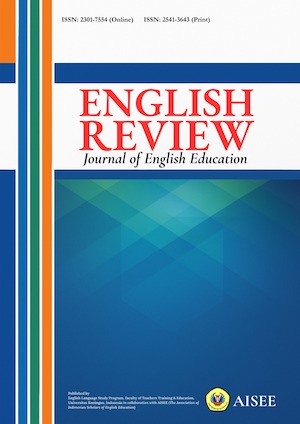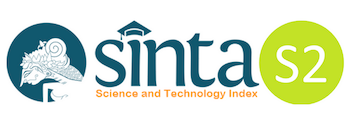DEVELOPING INTERACTIVE MULTIMEDIA-BASED ESP TO IMPROVE ENGLISH PROFICIENCY AND CAREER GUIDANCE AT UPMI MEDAN
Abstract
This research explored the development of an interactive multimedia-based English for Specific Purposes (ESP) program designed to enhance English proficiency and career guidance at UPMI Medan. It addressed a notable discrepancy between theoretical frameworks and practical needs in ESP, as students increasingly demanded courses that integrated both oral and written communication skills with job-related tasks. Applying the Kemp instructional design model, the research used a comprehensive multi-phase approach: assessing student proficiency levels, identifying instructional needs, designing tailored ESP content for Business Administration, Tourism, and Public Speaking, and incorporating multimedia platforms such as Udemy and Gaminik. Key findings revealed that 40% of students prioritized mastering business correspondence, 58% sought improved communication skills for meetings, and 48% were interested in tourism-specific English. The research highlighted the effectiveness of flipped learning and interactive multimedia in overcoming vocabulary challenges and boosting engagement. Ultimately, it emphasized the need to integrate career-focused modules into ESP courses to better align language skills with career aspirations, thereby enhancing employability and professional readiness.References
Adi, S. S. (2023). Hybrid learning of ESP in agriculture field: Students’ perceptions and learning experiences. JEES: Journal of English Educators Society, 8(1), 63-73.
Almashhadani, M., & Almashhadani, H. A. (2023). English translations in project management: Enhancing cross-cultural communication and project success. International Journal of Business and Management Invention, 12(6), 291-297.
Anggayana, I. W. A. (2023). Integrating linguistic theories into English language education in tourism sectors: A comprehensive framework. Jurnal Manajemen Pelayanan Hotel, 7(2), 891-918.
Awad, F. B., Shaleh, M., Rezki, A., Jufra, A. A., & Tonn-Meller, H. (2024). Navigating diverse career paths: Students’ perception on career counseling need in Islamic universities. Jurnal Kajian Bimbingan dan Konseling, 9(1), 68-74.
Beckett, S. J. (2023). The apotheosis of steve jobs: Belief and desire in the discourse of design. Design and Culture, 15(1), 69-87.
Bhatia, V. K., & Bremner, S. (2012). English for business communication. Language Teaching, 45(4), 410-445.
Cabrelli, J., & Iverson, M. (2024). Why do learners overcome non-facilitative transfer faster from an L2 than an L1?: The cumulative input threshold hypothesis. International Journal of Multilingualism, 21(3), 1594-1620.
Colley, M., Speidel, O., Strohbeck, J., Rixen, J. O., Belz, J. H., & Rukzio, E. (2024). Effects of uncertain trajectory prediction visualization in highly automated vehicles on trust, situation awareness, and cognitive load. Proceedings of the ACM on Interactive, Mobile, Wearable and Ubiquitous Technologies, 7(4), 1-23.
Fan, Y. S. (2024). Facilitating content knowledge, language proficiency, and academic competence through digital storytelling: Performance and perceptions of first-year medical-related majors. Journal of Research on Technology in Education, 56(2), 129-150.
Hastutie, G., & Ramli, M. (2024). Desain pembelajaran: Model dick & carey, jerold e. kemp. An-Nashr: Jurnal Ilmiah Pendidikan dan Sosial Kemasyarakatan, 2(1), 41-51.
Hsu, T. C., Chen, W. L., & Hwang, G. J. (2023). Impacts of interactions between peer assessment and learning styles on students’ mobile learning achievements and motivations in vocational design certification courses. Interactive Learning Environments, 31(3), 1351-1363.
Jailani, M. S. (2023). Teknik pengumpulan data dan instrumen penelitian ilmiah pendidikan pada pendekatan kualitatif dan kuantitatif. IHSAN: Jurnal Pendidikan Islam, 1(2), 1-9.
Kang, L., He, S., Wang, M., Long, F., & Su, J. (2023). Bilingual attention based neural machine translation. Applied Intelligence, 53(4), 4302-4315.
Kowalski, A. E. (2023). How to examine external validity within an experiment. Journal of Economics & Management Strategy, 32(3), 491-509.
Lai, C. J. (2023). Teacher-student interaction for English-medium instruction (EMI) content and language learning and the effects of implementing multimodal input of classroom interaction: University students’ perceptions. English Language Teaching, 16(1), 52-69.
Lantolf, J. P., & Poehner, M. E. (2023). Sociocultural theory and classroom second language learning in the east asian context: Introduction to the special issue. The Modern Language Journal, 107(1), 3-23.
Marcet, E., & Sasamoto, R. (2023). Examining interlanguage pragmatics from a relevance-theoretic perspective: Challenges in L2 production. Intercultural Pragmatics, 20(4), 405-427.
Marzuki, M. (2023). The effect of implementing a cooperative learning model of group investigation type on student learning outcomes on ecosystem materials in class xa of state middle school 2 sintang. NUSRA: Jurnal Penelitian dan Ilmu Pendidikan, 4(4), 1091-1101.
Morales, R. O., & Limpot, M. (2023). A structural relationship model of communicative competence. Asian Journal of Education and Social Studies, 47(1), 26-42.
Musdalifah, A., Bangsawan, I., & Astika, A. J. (2024). The trends in need analysis of ESP for engineering students: Systematic literature review. Didaktika: Jurnal Kependidikan, 13(1), 1149-1164.
Nabung, A. (2024). Exploring teacher professional development in English for specific purposes among tertiary EFL educators in Indonesia. ESP International Journal of English Literature and Linguistics Research (ESP-IJELLR), 2(2), 1-8.
Palanisamy, B., & Rajasekaran, V. (2024). Insights into the dynamic relationship between technology and task-based language teaching: A critical review. International Journal of Learning, Teaching and Educational Research, 23(2), 402-420.
Plyth, P. S., & Craham, C. P. (2023). Translation affects literary and cultural systems: How to observe the features of translation?. Applied Translation, 17(1), 7-15.
Poluektova, O., Kappas, A., & Smith, C. A. (2023). Using bandura's self-efficacy theory to explain individual differences in the appraisal of problem-focused coping potential. Emotion Review, 15(4), 302-312.
Sabrila, R. A. P., & Apoko, T. W. (2022). The effectiveness of podcast on listening skill for vocational school students. IDEAS: Journal on English Language Teaching and Learning, Linguistics and Literature, 10(2), 1177-1186.
Sener, B., & Mede, E. (2023). Promoting learner autonomy and improving reflective thinking skills through reflective practice and collaborative learning. Innovation in Language Learning and Teaching, 17(2), 364-379.
Stevani, M. (2024). Connecting world lexicons: Figurative language’s role in BBC news listening for intercultural competence. LETS: Journal of Linguistics and English Teaching Studies, 5(2), 117-129.
Stevani, M., & Ginting, F. Y. A. (2022). English teachers’ perspectives of learner autonomy in online reading comprehension in times of the COVID-19 pandemic. Journal Of Teaching And Learning In Elementary Education, 5(2), 166-189.
Stevani, M., & Tarigan, K. E. (2022). Need analysis of dyslexia students in English reading comprehension instructions. JEELS: Journal of English Education and Linguistics Studies, 9(2), 327-35
Sujinpram, N., & Wannaruk, A. (2024). Enhancing business email writing ability through the integration of genre-based approach and data-driven learning. International Journal of Instruction, 17(3), 255-274.
Sulistyowati, A. I., & Mukti, T. W. P. (2023). The EFL students’ anxiety in an online public speaking class at an indonesian university. Edukasi: Jurnal Pendidikan dan Pengajaran, 10(1), 62-77.
Umar, U., Purwanto, M. B., & Al Firdaus, M. M. (2023). Research and development: As the primary alternative to educational research design frameworks. JELL: Journal of English Language and Literature, 8(1), 73-82.
Wang, Y. (2023). Artificial intelligence technologies in college English translation teaching. Journal of psycholinguistic research, 52(5), 1525-1544.
Wenk, N., Penalver-Andres, J., Buetler, K. A., Nef, T., Muri, R. M., & Marchal-Crespo, L. (2023). Effect of immersive visualization technologies on cognitive load, motivation, usability, and embodiment. Virtual Reality, 27(1), 307-331.
Westengard, B. L. (2023). Language acquisition in the theological classroom: A case study in comprehensible input. Teaching Theology & Religion, 26(4), 135-143.
Wilczewski, M., & Alon, I. (2023). Language and communication in international students’ adaptation: A bibliometric and content analysis review. Higher Education, 85(6), 1235-1256.
Wolf, M. K., Bailey, A. L., Ballard, L., Wang, Y., & Pogossian, A. (2023). Unpacking the language demands in academic content and English language proficiency standards for English learners. International Multilingual Research Journal, 17(1), 68-85.
Zeb, A., Goh, G. G. G., Javaid, M., Khan, M. N., Khan, A. U., & Gul, S. (2023). The interplay between supervisor support and job performance: Implications of social exchange and social learning theories. Journal of Applied Research in Higher Education, 15(2), 429-448.
All articles published in English Review: Journal of English Education (ERJEE) are licensed under the Creative Commons Attribution 4.0 International License (CC BY 4.0).
Copyright Ownership
Authors retain the copyright of their articles and grant ERJEE the right of first publication. The journal is granted a non-exclusive license to publish, reproduce, and distribute the article in any format, medium, or platform, provided that proper credit is given to the original authors.
License Terms – CC BY 4.0
Under the Creative Commons Attribution 4.0 International License, others are free to:
- Share — copy and redistribute the material in any medium or format
- Adapt — remix, transform, and build upon the material for any purpose, even commercially
As long as they:
- Provide appropriate credit to the original author(s) and source
- Provide a link to the license (https://creativecommons.org/licenses/by/4.0/)
- Indicate if any changes were made
There are no restrictions on the reuse, reproduction, or adaptation of published articles as long as attribution is properly given.
Author Warranties
By submitting a manuscript to ERJEE, authors confirm that:
- The work is original and does not infringe any existing copyright.
- The manuscript has not been previously published and is not under consideration elsewhere.
- All sources and references are appropriately acknowledged.
- Necessary permissions have been obtained for any copyrighted materials used.









